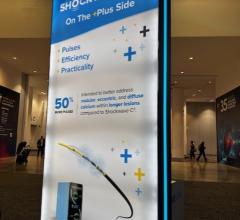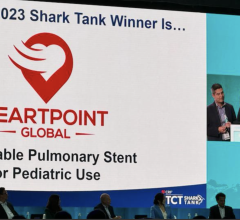
TAVR CT image reconstruction of an implanted Medtronic CoreValve.
November 9, 2021 — New five-year data from the SURTAVI trial found that there was no difference in all-cause mortality or stroke between patients at intermediate surgical risk who had transcatheter aortic valve replacement (TAVR) or surgery. Although there were initially more reinterventions after TAVR, the rates were similar after two years and key clinical endpoints were also similar.
Findings were reported today at TCT 2021, the 33rd annual scientific symposium of the Cardiovascular Research Foundation (CRF).
“Longer-term outcomes data from the SURTAVI randomized trial comparing early-generation TAVR to open-heart surgery are similar and encouraging for TAVR in younger, healthier patients with aortic stenosis,” said Nicolas M. Van Mieghem, M.D., Ph.D., professor of interventional cardiology, Thoraxcenter, Erasmus University Medical Center, Rotterdam, the Netherlands.
Early randomized TAVR trials enrolled patients at high operative risk with reserved long-term prognosis.
TAVR with balloon-expandable valves in intermediate-risk patients at five years was associated with higher rates of readmission and similar hemodynamics compared to surgery. Limited long-term data exists comparing surgery with self-expanding supra-annular TAVR.
A total of 1,660 intermediate-risk patients (risk of operative mortality ≥3% to <15%) underwent attempted implant of a transcatheter aortic valve (n=864) or a surgical valve (n=796) at 87 centers in Canada, Europe and the United States. Patients were stratified by investigational site and need for revascularization. Concomitant or staged PCI in the TAVR arm or coronary bypass graft in the surgical arm was performed as indicated.
The primary endpoint, consisting of the composite of death or disabling stroke at five years, were similar in both groups with 31.3% for TAVR and 30.8% for surgery (HR 1.02, 95% CI .085-1.22, p=0.85). All-cause mortality had similar rates and disabling stroke was 4.1% for TAVR compared to 5.8% for surgery (HR 0.69, 95% CI 0.43-1.10, p=0.12). At two years, reinterventions were higher with TAVR (2.5% versus 0.5%, log-rank p=0.002). However, at years three through five, the rates were similar. At five years, the reintervention rate for TAVR was 1.0% compared to 1.3% compared with surgery (log-rank p=0.60).
Core lab-assessed valve regurgitation showed that surgery patients had significantly less ≥ mild aortic regurgitation or paravalvular leak than TAVR at one, two and five-year follow-ups (all p < 0.001). Kansas City Cardiomyopathy Questionnaire summary scores were higher for TAVR patients at one year. However, the scores were similar at each additional follow up through five years. New York Heart Association Class was also similar between both groups at each follow up. In addition, forward-flow hemodynamics were significantly better with TAVR.
The study was funded by Medtronic. He reported the following disclosures: research grants from Abbott Vascular, Boston Scientific, Edwards Lifesciences, Medtronic, Daiichi Sankyo, Abiomed, PulseCath BV and Pie Medical.
Links to All the TCT 2021 Late-Breaking Clinical Trials
More structural heart technology news


 May 05, 2025
May 05, 2025 








